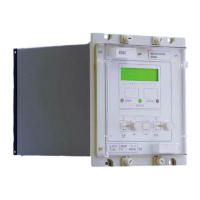VCG202/EN M/H11
Technical
7.4.5 Control status word
The control status word will be found in menu cell 000D. It is used to transfer control
information from the slave device to the master control unit.
7.4.6 Logic input status word
The status of the logic control inputs can be observed by polling menu cell 0020, where
the lowest 8 bits of the returned value indicates the status of each of the 8 logic inputs.
No control actions are possible on this cell other than to read it.
7.4.7 Output relay status word
The status of the output relays can be observed by polling menu cell 0021, where the
lowest 8 bits of the returned value indicates the status of each of the 8 output relays. No
control actions are possible on this cell other than to read it.
7.4.8 Alarm indications
The status of the internal alarms produced by the relays self test routine can be observed
by polling menu cell 0022, where the lowest 7 bits of the returned value indicates the
status of each of the alarms. No control actions are possible on this cell except for bit 6
which can be set/reset to test the watchdog relay.
7.4.9 Event records
An event may be a change of state of a control input or an output relay; it may be a
setting that has been changed locally; control function that has performed its intended
function. A total of 50 events may be stored in a buffer, each with an associated time tag.
This time tag is the value of a timer counter that is incremented every 1 millisecond.
The event records can only be accessed via the serial communication port when the relay
is connected to a suitable Master Station. When the relay is not connected to a Master
Station the event records can still be extracted within certain limitations:
The event records can only be read via the serial communication port and a
K-Bus/IEC 60870-5 Interface Unit will be required to enable the serial port to be
connected to an IBM or compatible PC. Suitable software will be required to run on the
PC so that the records can be extracted.
When the event buffer becomes full the oldest record is overwritten by the next event.
Records are deleted when the auxiliary supply to the relay is removed, to ensure that the
buffer does not contain invalid data. Dual powered relays are most likely to be affected.
The time tag will be valid for 49 days assuming that the auxiliary supply has not been lost
within that time. However, there may be an error of ±4.3s in every 24 hour period due to
the accuracy limits of the crystal. This is not a problem when a Master Station is on line
as the relays will usually be polled once every second or so.
The contents of the event record are documented in chapter 6, Chapter 6.2.
7.4.10 Notes on recorded times
As described in chapter 6, Chapter 6.2.2 the event records are appended with the value
of a 1 millisecond counter and the current value of the counter is appended to the start of
each reply form a relay. Therefore, it is possible to calculate how long ago the event took
place and subtract this from the current value of the real time clock in the PC.
If transmission is to be over a modem there will be additional delays in the
communication path. In which case the KITZ can be selected to append the real time at
which the message was sent and this value can then be used in the conversion of the
time tags. With this method of time tagging, the time tags for all relays on K-Bus will be
accurate, relative to each other, regardless of the accuracy of the relay time clock.
See also chapter 6, Chapter 6.2.4 for additional information on time tagging accuracy.

